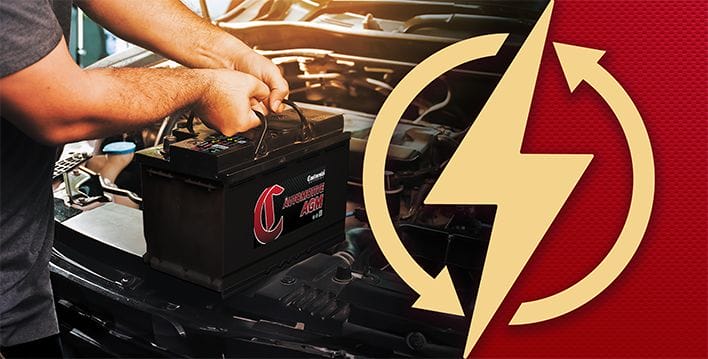
The battery is the heart of your vehicle, powering everything from the engine to the electronics you rely on daily — yet, it’s often misunderstood. From outdated advice about storage to misconceptions about charging, these myths can lead to unnecessary replacements, unexpected breakdowns and added frustration.
In this post, we’ll separate fact from fiction, tackling common automotive battery myths to help you better understand, maintain and maximize the life of your vehicle’s power source.
Battery Myth: A car battery can be fully charged by idling.
Okay, we’ll call this a “mostly myth.” While idling can charge a car battery, it would take days and a lot of wasted fuel. If your battery is dead and you just jumped it, idling will not provide the necessary juice to get your battery back up to driving shape.
Your car’s alternator charges the battery while the car is running, and driving at highway speeds is more effective than idling because the alternator operates at optimal output. However, the alternator is designed to maintain the battery, not fully recharge it. If your battery is at 50%, driving several hours at highway speeds may bring it closer to a full charge, but it’s unlikely to reach 100% from the alternator alone.
The best way to fully charge your battery is to use a compatible charger. Depending on the charger’s output and your battery’s capacity, it can take anywhere from four to 24 hours to charge fully.
Battery Myth: You don’t need to replace your battery until it fails.
Again, we’ll call this one a half-truth because if your battery fails, you need to replace it. But the smarter move — the one that won’t leave you stranded on the side of the road — is to replace your battery before it dies.
If you’re staying on top of checking and maintaining your car battery, you can tell when it’s time to start shopping for a replacement. Some telltale signs include:
- The engine struggles to start.
- Car accessories turn on, but the engine won’t start.
- The car starts irregularly.
- The battery smells like rotten eggs.
- The battery is visibly damaged.
- The battery is reaching its expected lifespan.
If you spot any early signs of failure, you can test your battery to determine if its performance and capacity have dropped. Proactively replacing a failing battery prevents inconvenient breakdowns and major headaches.
Battery Myth: Storing batteries on concrete drains their charge.
We’ll give your grandpa credit for this one. And while the advice may be as dated as a cassette tape deck on Pop-Pop’s dash, we’ll still call this one a used-to-be-true. That’s because in the olden days (like the 1960s), battery casings were made of porous rubber, which could absorb moisture from a damp garage floor. This created a conductive path that caused the battery to slowly discharge.
Modern batteries use nonporous plastic or polypropylene casings that prevent moisture absorption and electrical leakage. Storing batteries on a concrete floor today (as long as it’s dry and there’s no flooding risk) is safe. In fact, concrete floors may even help dissipate heat, and cooler storage temperatures are better for battery health.
Battery Myth: If your car won’t start, it’s always the battery’s fault.
When you turn the key in your ignition, and the car doesn’t start, it’s easy to assume a dead battery. That is sometimes the case, but not always. Other reasons could include:
- Faulty alternator. If the alternator isn’t charging the battery, it could mimic the signs of a dead battery when it simply needs a charge.
- Bad ignition switch. The ignition switch is the place your key goes in. Its job is to initiate the starting process by sending a start signal to the engine. If the switch is malfunctioning, the signal is interrupted, and the car won’t start.
- Clogged fuel filter. A clogged filter makes it harder for fuel to flow from the tank to the engine. This can prevent the engine from getting enough fuel to start.
- Empty gas tank. This one falls under user error, but we’ve all been there. Check your gauge and fill up your tank to get back on the road.
Of course, a dead battery is a common cause of a car that won’t start, but instead of assuming, look for additional signs that let you know it is the battery that needs attention.
- Your engine cranks slowly or not at all.
- The dashboard warning light indicates a battery issue.
- A clicking sound when turning the key.
- The headlights dim or flicker.
- Your car’s accessories aren’t working properly.
Testing the battery will confirm whether it's the root cause of your starting issues.
Myth: Jump-starting will recharge your battery.
This myth is debunked right in the name. When you jump-start a dead battery using another vehicle or a jump starter, you’re providing a temporary boost to get the engine running — not a full recharge. After jump-starting:
- Drive your vehicle. While driving helps the alternator replenish some of the charge, it won’t fully recharge a depleted battery in a reasonable timeframe.
- Charge your battery. If you’ve determined your battery is still in good shape, charge it fully with a compatible charger.
If you find you need to jump-start your battery repeatedly, there’s likely a problem with the battery or another component of your vehicle that needs to be addressed right away.
Myth: Cold weather kills car batteries.
Extreme cold weather causes the battery to work harder to provide the power to crank the engine. The electrochemical reaction that actually generates a battery's power is slowed when the temperatures drop below freezing.
And while your car may be harder to start in sub-zero winters, heat is actually the true enemy of the car battery. A weakened battery is more likely to fail when stressed by either extreme. The key to protecting your battery from extreme weather is to maintain it properly and ensure it’s healthy going into the coldest or hottest months.
Choosing the right battery is also key. If you frequently drive or park in extreme temps, a technology like MIXTECH can ensure a balanced electrolyte mix and prevent acid stratification, keeping your battery healthy longer and offsetting the effect of heat and cold.
Myth: All batteries are maintenance-free.
There are three main types of automotive batteries: Flooded lead-acid (FLA), absorbent glass mat (AGM) and enhanced flooded batteries (EFB). AGMs are generally considered maintenance-free because they are fully sealed and don’t require filling or topping off.
They are mainly used for modern vehicles with higher electrical demands, such as those with stop/start systems or heavy accessory use.
FLA batteries require some maintenance, including checking and topping off the electrolyte levels with distilled water (if they are not sealed) and regular checks for corrosion on terminals, which should be cleaned as needed. EFBs are similar to FLAS but offer better performance and durability; while sealed, they may still benefit from periodic inspections.
All batteries, even AGMs, benefit from general maintenance, like proper charging and storage when not in use.
Myth: A higher-cost battery is always better.
There are some cases where the adage “you get what you pay for” is 100% true. While batteries with advanced features or higher capacity often come with a premium price, cost isn’t the only factor in ensuring you get the best power source for your vehicle.
The key is choosing a battery that matches your vehicle’s specific needs, climate and usage patterns, rather than assuming the most expensive one is automatically the best fit.
Here’s a quick guide to choosing the best battery for your vehicle:
- Battery size. The correct group size will ensure the battery fits properly and meets power and connection needs.
- Vehicle type. If your car has advanced features like start/stop systems, opt for AGM or EFB. Conventional systems work well with an FLA.
- Climate. AGMs or even lithium-ion batteries work well in extreme temperatures.
- Usage. City driving that includes frequent, short trips calls for AGM or EFB, while FLA batteries work well for long distances.
Always consult your vehicle’s manual for exact battery specifications.
Questions About Your Battery?
Contact us or visit your nearest Continental Battery Systems location to learn more about choosing the best power source for your car — and possibly bust a few more battery myths.






